Isla de los Pájaros
My last full day in Argentina and a feeling of dread creeps over me as I start to contemplate the long day of airplane flights that I have ahead of me tomorrow. But I push these thoughts aside and focus instead on being here now. I take an early morning walk, going out to my favorite cliff on the edge of Puerto Pirámides. It was low tide, so a wide sandy beach revealed itself directly below me.
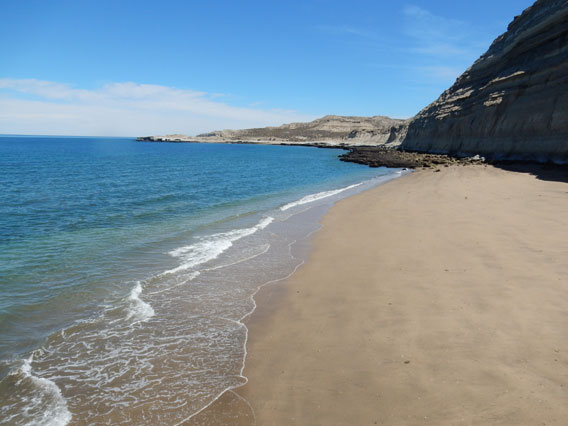
Looking out from my cliffside perch
Sitting on the cliff, looking out across the Golfo Nuevo, it doesn't take long before I see that familiar movement in the water, followed by a spout of water, then the surfacing of a whale. This time it was a mother and a calf, coming up together, playfully dancing around the sea. They stayed close to the surface for about five minutes before they rose up one final time and with a resplendent display of the tail dove down into the depths.
I came to realize that the Golfo Nuevo is one of the world's greatest wildlife shows. All you have to do is sit patiently and watch the deep blue rippling surface of the water, and within a few minutes, a whale (or two or three) will make its presence known. I loved my cliffside perch, just looking out at this glorious scene, taking in all of nature that was in front of me. It was a front row seat at the biggest theater production of all.
I look at a tiny little town like Puerto Pirámides, which has five different companies that offer whale watching trips. The impact on the local economy is tremendous. Each one of these outfits is taking out groups of 20-50 people to see the whales, several times a day. It's amazing to consider how the whale hunting industry used to play a tremendous role in the world economy, but in the process they depleted the very resource that was bringing them great wealth. Now the revenue coming in from whale watching tourism has a much more positive effect on local economies all over the world, without depleting the source of that revenue.
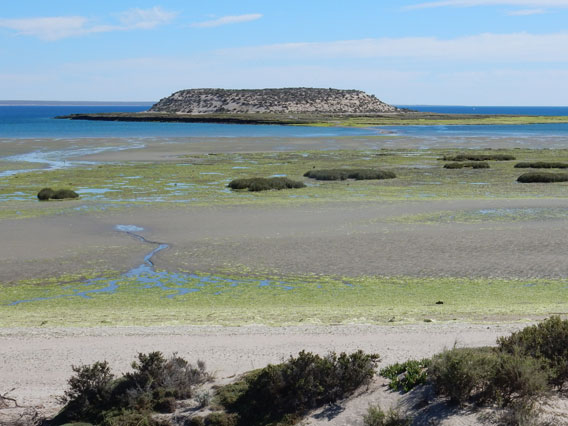
Isla de los Pájaros in the Golfo San José
After breakfast, I packed up my luggage and checked out of the hotel. From Puerto Pirámides, I drove back toward the mainland, taking a short side trip to the overlook at Isla de los Pájaros (Island of the Birds). This small rocky outcrop is just offshore in the el Golfo San José and offers a pristine sanctuary to cormorants, oystercatchers, herons, steamer ducks, and even Magellanic penguins. The island is not accessible to people, but the overlook has a raised observation deck with binoculars to get a close-up view of the birds.
Next to the overlook is a replica of the Capilla del Fuerte San José, the chapel of the old Spanish fort that was built a few kilometers north of here in 1779. The fort was destroyed in 1810 during an indigenous rebellion, forcing the Spanish to abandon their attempts to settle this remote corner of Patagonia for many years. I wandered around the chapel, checking out the many cuis chico (Microcavia australis) that scurried around in the bushes. Known as a southern mountain cavy in English, this small rodent is found mainly in southern Argentina.
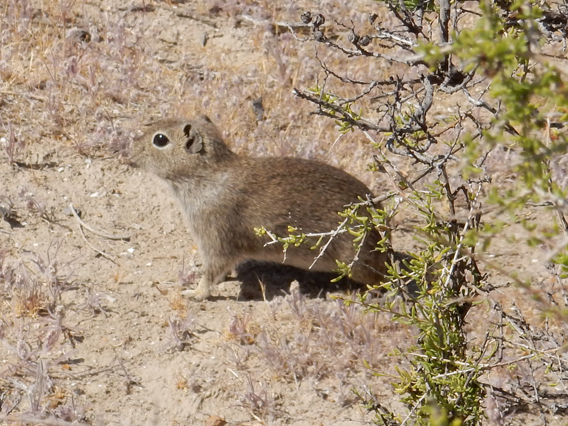
Cuis Chico (Microcavia australis)
When I left Isla de los Pájaros, it was time to return to the real world. I drove along the narrow isthmus that separates the Golfo Nuevo and the Golfo San José, heading to Puerto Madryn, the big city. With a population of about 100,000, Puerto Madryn is tiny compared to Buenos Aires, but after being on the wild Valdés Peninsula for several days, it felt like a sprawling metropolis.
This Patagonian city was big enough for me to get lost in as I drove around looking for the highway out of town. It was not so big though that it would have stop signs in residential neighborhoods, making each intersection a dangerous challenge. Apparently the rules of the road dictate that whoever has the biggest balls has the right of way.
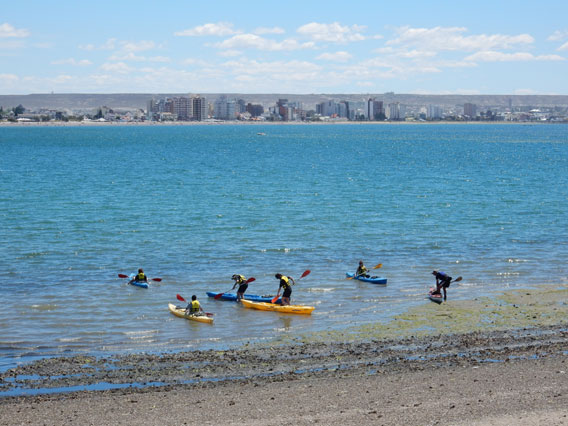
Kayakers launch in the Golfo Nuevo, with Puerto Madryn in the distance
I slowly found my way along the waterfront of the city, and then out the other side, where the Punta Loma sea lion rookery sits in an isolated cove along the Golfo Nuevo. There is a cliffside overlook of the rookery, with a large group of sea lions down on the beach below. Cormorants perch on the steep sides of the cliffs, coming and going from their precarious roosts. This small park also has a one-kilometer nature trail along the edge of the cliff, with interpretive exhibits about the native plants and how they were used by the indigenous people of Patagonia.
The Punta Loma sea lion rookery
I got into Trelew late in the afternoon and found a hotel near the center of town. It was a Sunday and Trelew was deserted, with almost all the shops and restaurants closed. I wandered around the center of town, sat in the empty plaza for a while, then found a small ice cream shop that was open. I had a small bowl of ice cream, then asked the waitress if there were any markets open at this time of day. She told me about a "chino" a couple of blocks away, where I could pick up groceries. A "chino" is a Chinese immigrant-owned grocery market, an indication of the major importance of immigration in the history of Argentina. Many immigrants groups have gravitated toward certain occupations and this tendency has worked its way into the national lexicon.
I found the "chino" and picked up some sandwiches and snacks, not the most exciting meal for my last night in Argentina, but some sustenance to tide me over to the next day.
| Next up: End of the Journey |

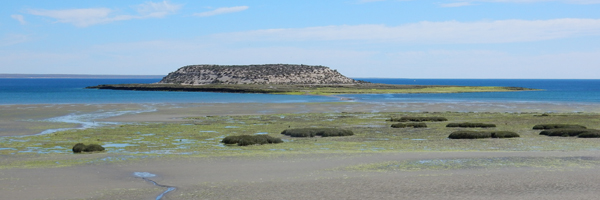
© 2016 Michael Hanrahan